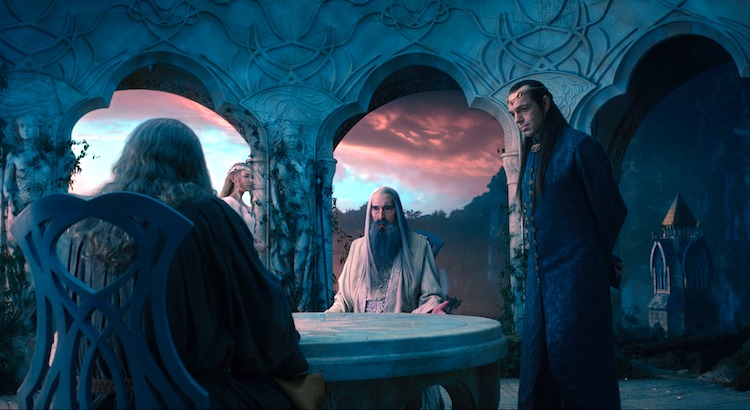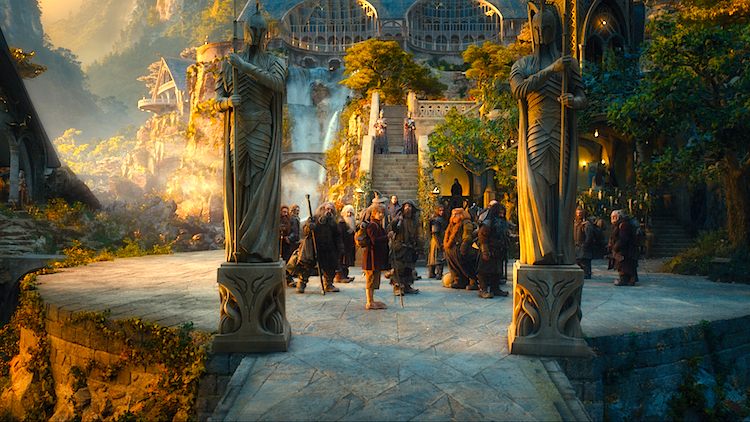By Joe Bendel. Does this sound familiar? A little dude with big feet saves the world. A magic ring is involved. Welcome back to Middle Earth. After the complete triumph of the Lord of the Rings trilogy, a big screen treatment for The Hobbit was almost inevitable. Fortunately, after a complicated development process, Peter Jackson retook the reins of what is now a prequel trilogy. As most anyone remotely connected to the media culture knows, Jackson’s The Hobbit: an Unexpected Journey opens today, just about everywhere.
Blink and you might miss him, but Frodo appears in passing early on. Of course, The Hobbit is Bilbo Baggins’ story, which he is writing out for Frodo’s edification. In his younger years, Baggins was recruited by Gandalf the Grey to aid a company of dwarves in reclaiming their ancestral home from an ancient dragon. A bookish homebody, Baggins cannot fathom what he would bring to the expedition, but Gandalf just seems to think it will be helpful to have a hobbit along. Thorin Oakenshield, the fiery heir to the Dwarvish throne, is openly contemptuous of Baggins, but several of his compatriots eventually warm to their halfing compatriot.
Thorin also makes no secret of his resentment for the Elvish kingdom, whom he blames for turning their backs on the Dwarves in their hour of need. However, Gandalf insists they will need their assistance deciphering a certain magical map. They could also use a hand with the orc hordes pursuing them through the mountains. Frankly, there should not be so many trolls and goblins roaming about the foothills. There seems to be an evil agency at work, with most signs pointing to the former Dwarvish homeland.
Considering The Hobbit is just one average sized book and The Lord of the Rings is a fat trilogy, one would expect a lot of filler in Unexpected Journey. Yet, since about seventy-five percent of the film consists of the orcs chasing or battling the dwarves, its nearly three hours do not seem so excessively padded (as long as you enjoy fantastical action).

All that melee looks great in 3D. No lame 2D fix-up (like Clash of the Titans), Journey was clearly conceived for the format. However, the High Frame Rate (HFR) gimmick is another story. Frankly, the super sharp clarity of the image often makes the effects look more fake, rather than the opposite. Also, the early scenes in Bag End lack the warm, cozy vibe one would expect.
Even if HFR is more of a distraction than an attraction, Jackson gets the bigger Tolkien picture. He understands and always remains true to the series’ themes of sacrifice, faith, courage, and humility. Fans trust him adapting this world, with good reason, so if the HFR experiment is the price to pay for Jackson’s return to Middle Earth, it is probably worth it.
Journey might not be as epic as its LOTR predecessors, but it does not disappoint. Martin Freeman (Sherlock’s Dr. Watson) has the right everyhobbit presence and looks quite credible as Sir Ian Holm’s younger analog. Most importantly, Sir Ian McKellen is back as Gandalf, a role he was probably born to play. Hammer fans will also be pleased to see Sir Christopher Lee return as Saruman the White. It is sort of more of the same, but Jackson makes it feel right even when it looks a little weird. Recommended for fantasy fans, The Hobbit is now playing on over 4,000 screens nationwide, including the AMC Loews Lincoln Square in New York.
LFM GRADE: B
Posted on December 14th, 2012 at 9:45am.
